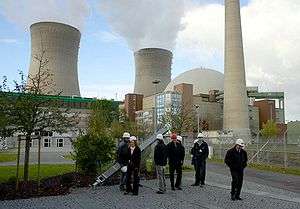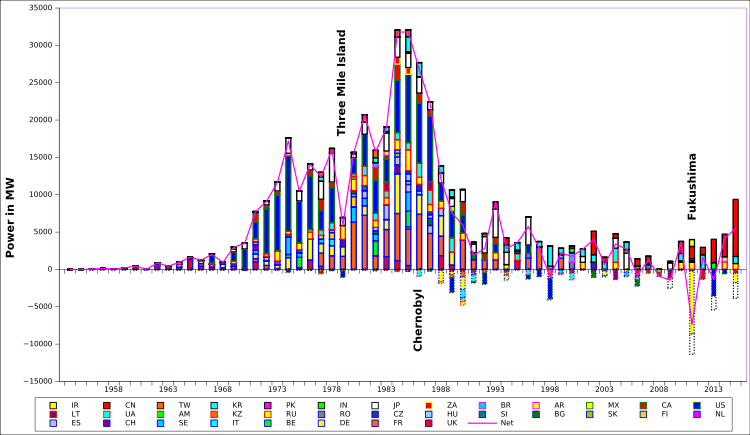Nuclear power by country


Nuclear power plants operate in 31 countries. Most are in Europe, Northern America, East Asia and South Asia.
France has the largest share of electricity generated by nuclear power. China has the fastest growing nuclear power program with 28 new reactors under construction,[3] and a considerable number of new reactors are also being built in India, Russia and South Korea. At the same time, at least 100 older and smaller reactors will "most probably be closed over the next 10–15 years".[4]
In 2010, before the Fukushima Daiichi nuclear disaster, it was reported that an average of about 10 nuclear reactors were expected to become operational per year, although according to the World Nuclear Association, of the 17 civilian reactors planned to become operational between 2007 and 2009, only five actually came on stream.[4] As of 2016, Italy closed all of its nuclear stations and Belgium, Germany, Spain, and Switzerland are phasing-out nuclear power while Netherlands, Sweden, and Taiwan have some same intentions. Lithuania and Kazakhstan shut down lone nuclear stations earlier but plan to built new ones instead. Armenia earlier shut down its lone nuclear plant but then started to utilize it again. Austria never started to utilize it s first nuclear plant that was completely built. Due to financial, politic and technical reasons, Cuba, Libya, North Korea, and Poland never completed the construction of their first nuclear plants (but the latter two plan the nuclear stations again) and Australia, Azerbaijan, Georgia, Ghana, Ireland, Kuwait, Oman, Peru, Singapore, and Venezuela never built their planned first nuclear plants.[5][6] Global nuclear electricity generation in 2012 was at its lowest level since 1999.[7][8]
As of 2011, countries such as Australia, Austria, Denmark, Greece, Ireland, Italy, Latvia, Liechtenstein, Luxembourg, Malaysia, Malta, New Zealand, Norway, Philippines, and Portugal have no nuclear power stations and remain opposed to them.[5][9]
Canadian Bruce Nuclear Generating Station is the largest nuclear power plant now whereas Japanese Kashiwazaki-Kariwa was regarded as such earlier.
Overview
Of the thirty countries in which nuclear power plants operate, only France, Hungary, Slovakia and Ukraine use them as the source for a majority of electricity, although many other countries have a significant nuclear power generation capacity.[10] According to the World Nuclear Association, a nuclear power advocacy group, over 45 countries are giving "serious consideration" to introducing a nuclear power capability, with Belarus, Iran, Jordan, Turkey, the United Arab Emirates and Vietnam at the forefront.[11] China, India and South Korea are pursuing ambitious expansions of their nuclear power capacities, with China aiming to increase capacity to at least 80 GWe by 2020, 200 GWe by 2030 and 400 GWe by 2050.[12] South Korea plans to expand its nuclear capacity from 20.7 GWe in 2012 to 27.3 GWe in 2020 and to 43 GWe by 2030.[13] India aims to have 14.6 GWe nuclear power generation capacity by 2020 and 63 GWe by 2032 and to have 25% of all electricity supplied by nuclear power by 2050.[14][15]
| Country | Number of operated reactors |
Capacity Net-total (MWe) |
Generated electricity (GWh) |
%-share of domestic generation |
|---|---|---|---|---|
| |
2 | 1009 | 2954.01 | 0.53% |
| |
3 | 1632 | 6519.00 | 4.83% |
| |
1 | 375 | 2576.00 | 34.51% |
| |
7 | 5913 | 24571.70 | 37.53% |
| |
2 | 1884 | 14809.16 | 2.76% |
| |
2 | 1926 | 15379.00 | 31.32% |
| |
19 | 13524 | 98374.97 | 16.60% |
| |
35 | 28792 | 170355.00 | 3.03% |
| |
6 | 3930 | 25337.32 | 32.53% |
| |
4 | 2752 | 22323.00 | 33.74% |
| |
58 | 63130 | 416800.00 | 76.34% |
| |
8 | 10799 | 86810.32 | 14.09% |
| |
4 | 1889 | 14955.71 | 52.67% |
| |
21 | 5780 | 34644.45 | 3.53% |
| |
1 | 915 | 3547.00 | 1.27% |
| |
43 | 40290 | 4346.49 | 0.52% |
| |
30 | Unknown | 0.00 | 0.00% |
| |
25 | 2333 | 157196.00 | 31.73% |
| |
1 | 482 | 3861.63 | 3.67% |
| |
2 | 1440 | 11176.54 | 6.79% |
| |
4[16] | 1030 | 4332.70 | 4.40% |
| |
2 | 1300 | 10695.00 | 17.33% |
| |
35 | 25443 | 195213.58 | 18.59% |
| |
4 | 1814 | 14083.68 | 55.90% |
| |
1 | 688 | 5371.66 | 38.01% |
| |
2 | 1860 | 10965.14 | 4.73% |
| |
7 | 7121 | 54740.00 | 20.34% |
| |
10 | 9651 | 54347.00 | 34.33% |
| |
5 | 3333 | 22100.00 | 33.48% |
| |
6 | 5052 | 35143.03 | 16.32% |
| |
15 | 13107 | 82300.00 | 56.49% |
| |
15 | 8918 | 63894.54 | 18.87% |
| |
99 | 99185 | 797178.00 | 19.50% |
| World total | 479 | 387,106 MWe | 2,798 TWh | 10.9%[17] |


|
Operating reactors, building new reactors Operating reactors, planning new build No reactors, building new reactors No reactors, planning new build |
Operating reactors, stable Operating reactors, considering phase-out Civil nuclear power is illegal No reactors |


List of reactors of nuclear plants by country
Only the commercial reactors registered with the International Atomic Energy Agency (as of January 2016) are listed below.
| Country | Operating | Under construction |
References and notes |
|---|---|---|---|
| |
2 | 1 | |
| |
3 | 1 | |
| |
1 | 0 | Replacement[18] |
| |
0 | 2 | Under construction |
| |
7 | 0 | |
| |
2 | 1 | [19] |
| |
2 | 0 | Four reactors were shut down in 2004 and 2007. Belene Nuclear Power Plant construction was officially terminated in March 2012.[20] |
| |
19 | 0 | 2 new reactors at Darlington planned |
| |
35 | 20 | 58 GWe by 2020 |
| |
6 | 0 | |
| |
0 | 2 | 4 reactors expected to be completed by 2024 [21] |
| |
4 | 1 | As of 2012, TVO is planning a new reactor to be built and operational by 2020.[22] |
| |
58 | 1 | First French EPR under construction at Flamanville |
| |
9 | 0 | Phase-out in place by 2022. |
| |
4 | 0 | Paks2 [2*1200MW] signed with Rosatom in 2014. |
| |
21 | 6 | Six reactors with a cumulative capacity of 4300 MW are under construction as of 2016. |
| |
1 | 0 | The first reactor of Bushehr Plant has power generation capacity of 915 MW[23] |
| |
48 | 2 | After Fukushima, Japan shut down all of its 54 nuclear reactors, 6 of them permanently; 48 remain operational, 5 have been approved for restart, but 2 have been stopped after restarting by a district court injunction.[24] |
| |
2 | 0 | |
| |
1 | 0 | |
| |
30 | 0 | |
| |
3 | 2 | |
| |
2 | 0 | 20 January 2011, GDF Suez, Iberdrola and RWE pulled out of the project. |
| |
34 | 9 | 9 new reactors expected to be completed by 2020 |
| |
0 | 16 | http://www.world-nuclear.org/information-library/country-profiles/countries-o-s/saudi-arabia.aspx |
| |
4 | 0 | |
| |
1 | 0 | |
| |
2 | 0 | South Africa will be building a further 9600 MW, 6-8 reactors, by 2030[25][26] |
| |
25 | 3 | |
| |
7 | 0 | Stable[27] |
| |
10 | 0 | |
| |
5 | 0 | Phase-out in place, first decommissioning 2029.[28] |
| |
6 | 0 | |
| |
0 | 2 | |
| |
15 | 2 (IAEA) or 0 (WNA) | 2 new reactors by 2018.[29][30] One destroyed in 1986. |
| |
0 | 4 | 4 reactors expected to be operational 2017-2020[31][32] |
| |
16 | 0 | |
| |
99 | 5 | |
| World | 446 | 65 (IAEA) or 63 (WNA) |
See also
- List of nuclear reactors
- Nuclear energy policy by country
- Nuclear power accidents by country
- Uranium reserves
- World Nuclear Industry Status Report
- Nuclear industry in Canada
- Category:Nuclear power by country
References
- 1 2 "World Nuclear Power Reactors & Uranium Requirements". World Nuclear Association. 1 October 2010. Retrieved 23 October 2010.
- ↑ Annika Breidthardt (30 May 2011). "German government wants nuclear exit by 2022 at latest". Reuters.
- ↑ "China Nuclear Power - Chinese Nuclear Energy".
- 1 2 Michael Dittmar. Taking stock of nuclear renaissance that never was Sydney Morning Herald, 18 August 2010.
- 1 2 Duroyan Fertl (5 June 2011). "Germany: Nuclear power to be phased out by 2022". Green Left.
- ↑ James Kanter (25 May 2011). "Switzerland Decides on Nuclear Phase-Out". New York Times.
- ↑ WNA (20 June 2013). "Nuclear power down in 2012". World Nuclear News.
- ↑ "The Nuclear Renaissance".
- ↑ "Nuclear power: When the steam clears". The Economist. 24 March 2011.
- 1 2 "Nuclear Share of Electricity Generation in 2015". IAEA. 30 April 2016. Retrieved 1 May 2016.
- ↑ "Emerging Nuclear Energy Countries". World Nuclear Association. April 2013. Retrieved 14 April 2013.
- ↑ "China Nuclear Power". World Nuclear Association. April 2013. Retrieved 14 April 2013.
- ↑ "Nuclear Power in South Korea". World Nuclear Association. February 2013. Retrieved 14 April 2013.
- ↑ "Nuclear Power in India". World Nuclear Association. 10 April 2013. Retrieved 14 April 2013.
- 1 2 3 "Operational & Long-Term Shutdown Reactors". IAEA. 13 April 2013. Retrieved 14 April 2013.
- ↑ http://indianexpress.com/article/world/world-news/pakistans-4th-nuclear-power-plant-of-340-mw-starts-operation-3086731/
- ↑ "2015 Key World Energy Statistics" (PDF). IEA. 2016. p. 18.
World electricity generation by fuels in 2015; from the international Energy Agency report Key World Energy Statistic, 2016 edition.
- ↑ "USA supports new nuclear build in Armenia". World Nuclear News. 23 November 2007. Retrieved 25 November 2007.
- ↑ Agência Estado (12 September 2008). "Lobão diz que país fará uma usina nuclear por ano em 50 anos" (in Portuguese). G1.globo.com. Retrieved 15 October 2008.
- ↑ Bulgaria quits Belene Nuclear Power Plant project, Novinite, 28 March 2012
- ↑ "Egypt, Russia sign deal to build a nuclear power plant". reuters.com.
- ↑ "Kolme uutta reaktoria, Jees!". Tekniikka ja talous. 15 October 2009. Retrieved 3 December 2009.
- ↑ F_405. "Iran's Bushehr nuke power plant at full capacity from May 23: Russian contractor - People's Daily Online". English.peopledaily.com.cn. Retrieved 28 January 2013.
- ↑ Japan/Nuclear Power in Japan, World Nuclear Association, 27 January 2015
- ↑ "Nuclear Power in South Africa". Retrieved 12 April 2015.
- ↑ "S.Africa wants nuclear contracts to stay at home". Reuters. 23 April 2012. Retrieved 28 January 2013.
- ↑ Nuclear power in Spain, World Nuclear Association, URL accessed 13 June 2006
- ↑ Associated Press (28 September 2011). "Swiss Nuclear Power Plan Moves Toward Phase-Out Of Reactors". Huffingtonpost.com. Retrieved 28 January 2013.
- ↑ "BBC NEWS | Politics | New nuclear plants get go-ahead". News.bbc.co.uk. 10 January 2008. Retrieved 18 April 2015.
- ↑ "Nuclear Power in Ukraine". World Nuclear Association. August 2008. Retrieved 22 September 2008.
- ↑ "Nuclear Power United Arab Emirates | UAE Nuclear Energy | Abu Dhabi | Dubai". www.world-nuclear.org. Retrieved 19 October 2015.
- ↑ "UAE's fourth power reactor under construction - EE Publishers". EE Publishers. Retrieved 19 October 2015.